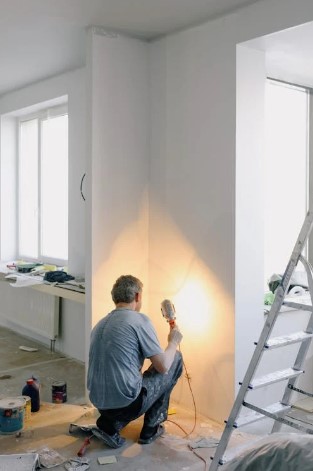Stucco is a durable and versatile exterior finish that has been used in home construction for centuries. It offers a classic, aesthetically pleasing look while also providing protection against weather elements. However, like any other material, stucco is not immune to wear and tear. Over time, cracks, holes, and other damages can appear, necessitating repairs to maintain both its appearance and functionality.
In this comprehensive guide, we will cover everything you need to know about stucco repair, from identifying damage to executing the perfect fix. This guide is designed to help homeowners protect their property and maintain its beauty, ensuring that their investment in stucco pays off in the long run.
What is Stucco?
Stucco is a plaster-like material made from cement, sand, and water. It is typically applied to the exterior of homes in layers to create a strong, weather-resistant finish. Stucco is a popular choice for both residential and commercial buildings due to its durability, low maintenance, and attractive appearance. It can be applied over a variety of surfaces, including wood, concrete, and brick, making it a versatile option for many types of construction.
Stucco can come in various textures, colors, and finishes, making it ideal for customizing the look of a home. It can mimic stone, brick, or even be smoothed to create a more modern appearance.
Common Causes of Stucco Damage
While stucco is known for its resilience, it can still become damaged due to several factors. Understanding the common causes of stucco damage can help you identify problems early and prevent further deterioration.
- Moisture Intrusion: One of the primary causes of stucco damage is water infiltration. If water gets behind the stucco, it can weaken the material, causing it to crack and crumble over time. This is often the result of poor installation or faulty seals around windows and doors.
- Foundation Shifting: As a house settles or experiences shifting in its foundation, cracks can form in the stucco. These cracks may start small but can grow over time if left unattended.
- Weather Conditions: Extreme weather, including heavy rains, strong winds, and fluctuating temperatures, can wear down stucco over time. Freeze-thaw cycles are particularly damaging, as expanding water trapped in the stucco can cause it to crack.
- Physical Impact: Accidental damage from items like ladders, lawn equipment, or hail can create cracks or holes in stucco surfaces.
Identifying Stucco Damage
Before you can repair stucco, you need to know how to identify signs of damage. Stucco damage often starts small but can quickly escalate if ignored.
- Cracks: Small hairline cracks may not seem like a big deal, but they can let moisture in, which can lead to more significant damage.
- Discoloration: Dark spots or patches on your stucco may indicate moisture infiltration. Water stains are a common sign of leaks behind the stucco.
- Bulging or Sagging: If sections of your stucco are bulging or sagging, it could mean that the material beneath the stucco has been compromised, usually by water damage.
- Holes: Holes or missing sections of stucco should be addressed immediately, as they leave the underlying structure exposed to the elements.
Types of Stucco Cracks
Understanding the types of cracks in stucco can help you determine the severity of the issue and the appropriate repair method. Here are the most common types of stucco cracks:
- Hairline Cracks: These are the smallest cracks, often caused by shrinkage of the stucco as it cures. They are generally less than 1/16th of an inch wide and are mostly cosmetic.
- Diagonal Cracks: These cracks typically occur around windows and doors and can indicate structural movement in the building.
- Spider Cracks: These cracks resemble a spider web and are usually caused by improper application of the stucco or inadequate curing time.
- Pattern Cracks: These cracks often form in a grid-like pattern and are caused by issues with the underlying structure, such as improper installation of lath or insufficient expansion joints.
Preparing for Stucco Repair
Before diving into the repair process, it’s important to properly prepare the area and gather the necessary materials. Here’s what you need to do:
- Clean the Surface: Use a wire brush or pressure washer to remove dirt, debris, and loose stucco from the damaged area. This will help the new stucco adhere better.
- Assess the Damage: Determine whether the damage is minor, moderate, or severe. Minor cracks can often be repaired with caulking, while more significant damage may require patching or even full replacement of the affected section.
- Gather Materials: You’ll need stucco mix, a trowel, a hawk, a wire brush, and a sponge. For larger repairs, you may also need a mesh lath or bonding agent.
Step-by-Step Stucco Repair Process
Now that you’ve assessed the damage and prepared the area, it’s time to begin the stucco repair process. Follow these steps to ensure a professional-looking result:
1. Mix the Stucco
Prepare your stucco mix according to the manufacturer’s instructions. Be sure to mix enough to cover the damaged area but avoid mixing too much, as stucco can dry quickly.
2. Apply a Bonding Agent
For repairs involving deep cracks or large holes, apply a bonding agent to help the new stucco adhere to the existing surface. This step is especially important if the original stucco has become crumbly or weak.
3. Apply the First Layer of Stucco
Using a trowel, apply the first layer of stucco over the damaged area. This layer should be about 1/4-inch thick. Press it firmly into the crack or hole to ensure a strong bond. Allow this layer to dry for about 24 to 48 hours, depending on the climate.
4. Apply Additional Layers
Once the first layer has dried, apply a second layer of stucco, slightly thicker than the first. If necessary, add a third layer, allowing each to dry in between. Smooth the surface with a trowel for a uniform appearance.
5. Texture the Surface
If your stucco has a specific texture, use a brush, sponge, or trowel to recreate the desired finish while the final layer is still wet.
6. Paint or Seal the Stucco
Once the stucco has fully dried (usually after a few days), you can paint or seal the surface to match the rest of your home. Be sure to use a paint that is designed for stucco to ensure long-lasting results.
Preventing Future Stucco Damage
After repairing your stucco, taking steps to prevent future damage can save you time and money. Here are a few tips to help maintain your stucco:
- Regularly Inspect Your Stucco: Periodically check for cracks, discoloration, or other signs of damage. Catching problems early can prevent costly repairs later.
- Ensure Proper Drainage: Make sure your gutters and downspouts are directing water away from your home. Poor drainage can lead to moisture buildup behind your stucco.
- Seal Around Windows and Doors: Use caulking or weatherproof sealant around windows, doors, and other openings to prevent moisture infiltration.
- Maintain the Paint or Sealant: Reapply paint or sealant every 5 to 7 years to protect your stucco from the elements.
When to Call a Professional
While many stucco repairs can be handled by homeowners, there are instances where it’s best to call in a professional. If the damage is extensive, involves structural issues, or if you’re unsure of how to proceed, hiring an experienced stucco contractor can ensure the job is done correctly.
Professional contractors have the tools, expertise, and materials needed to tackle large-scale repairs, and they can also help prevent future problems by addressing underlying issues.
Conclusion
Stucco is a beautiful and durable material that can last for decades when properly maintained. However, like any exterior surface, it requires regular care and occasional repairs to remain in top condition. By understanding the causes of stucco damage, knowing how to identify problems early, and following the correct repair techniques, you can protect and beautify your home for years to come.
Whether you're a seasoned DIYer or prefer to hire a professional, taking care of your stucco will ensure that your home remains both functional and visually appealing. Don't wait for small cracks to turn into major issues—address them early to preserve the integrity of your home’s exterior.






Comments